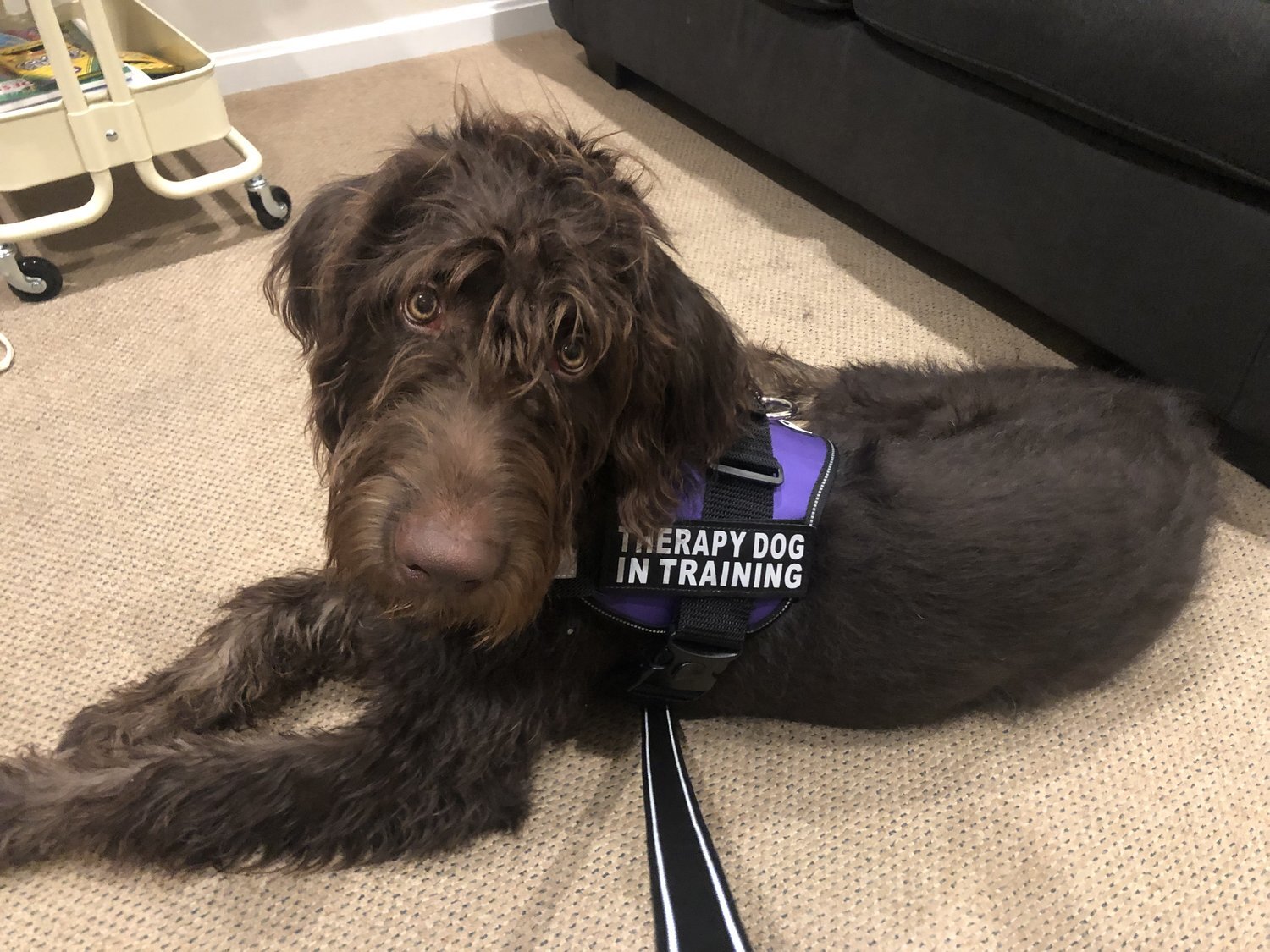
Is There Specific Training My Dog Needs to Become a Therapy Dog?
Short Answer: No.
Long, ethical and less likely to get you in long-term trouble answer: Yes. You might be surprised to learn, there is no regulating body for therapy dogs. Same with service dogs. No one controls the training they "must" go through to be working dogs in the helping field. There are many websites out there claiming to register your dog and give it special identification. These websites are charging people to give them certificates and patches that are essentially useless outside of show. Yes, maybe you like the vest (I just ordered Franklin one from Chewy) but there is no requirement to register your dog or put your dog through a specific training.(Side note: The ADA does not require service dogs to be registered. Actually, mandatory registration of a service animal (as a service animal) is not legal under the ADA, and the ADA states clearly on their website that a service animal does not need any professional training (it still has to be trained to do one task that is not a typical dog task that assists with a diagnosed disability), nor does it need any sort of identification like cards, vests, or special leashes. If you have a service animal, it is illegal for someone to question you more than asking if “the dog is a service animal required because of a disability” and “what work or task the dog has been trained to perform.” That's it. Now, let me remind you that it is extremely unethical (and maybe even illegal) to misrepresent yourself as disabled just to bring a dog into a public place.)But this article is about therapy dogs, so I will try to stay focused for the rest of the time! The American Kennel Club is a highly regarded all breed dog registry but not a governing body over dog training. Interestingly enough (I'm distracted again), there is no governing body over yoga instructors either but the Yoga Alliance has taken steps to increase the credibility of yoga instructor training, just as the AKC has taken steps to increase the training of therapy dogs. And this is important! Training a dog is no easy task! It takes consistency, commitment, time and money. If every therapist out there just took their pet to work and called it a therapy animal, there would likely be a lot negative interactions between "therapy animals" and clients.
For my training with Franklin, after extensive research I chose to go by AKC standards. For the purpose of this article, the training needed I speak of will be based on their standards.The American Kennel Club has a Therapy Dog Program which they write they created to “recognize” therapy dogs and the work that they are doing as volunteers. Interesting, right? Recognizing not regulating. Anyway, to qualify you have to meet three qualifications: be certified/registered by an AKC recognized therapy dog organization, be registered with the AKC, and perform the number of visits for the title you are applying for (we’ll get to that).

My YTT Story - BJ

My YTT Story - Courtney
Before I found myself signing up for my teacher training, I was repeating over and over how I did not want to teach yoga, only practice. Despite saying that, I sought out a teacher training and signed up. Looking back, I am not even sure when or how I changed my mind. When I entered into teacher training, I was unsure of myself or what the experience would be like. During my YTT, I was challenged in ways I didn’t expect to be, leading me to becoming a person I didn’t expect that I could become. Yes, I learned about the body and I learned about the postures but I also learned yoga philosophy, which guided me to follow my bliss and to learn what I needed to, whatever that was, to find myself again. By graduation, I uncovered my "self" - the part of me that I had buried down deep inside while I was busy being the person I thought everyone else wanted me to be.My yoga teacher training set a fire inside of me.

Therapy Animals: We're More Than Just Good Looks & Charm!
Last week, I tackled the difference between service animals, emotional support animals, and therapy animals. This week, a quiz! Just kidding.
On a more serious note, do you know how many different types of therapy animals there are out there? Today, we take a step away from learning about canine assisted therapy to focus on some other species and the different benefits they bring. Sometimes they are “friendly visitors,” like the pioneers of social work in the 1800s, other times their work is more therapeutically structured. Either way, therapy animals are cute and often times cuddly, but they bring way more than just their good looks and charm!
There are a lot of great programs locally that work with therapy animals besides canines! Most recently in Harford County, The Center for Trauma, Stress and Anxiety starting an Equine Therapy Program. Equine therapy can assist with treating PTSD, anxiety and depression, along with attachment and other trauma related disorders. There are also many different kinds of Equine Assisted Therapies including therapies for mental health, occupational or physical therapies, and personal/professional development. I have had clients in the past who struggled to connect to talk, play or art therapies have great success working with horses, and I believe that this occurred because of the power of the human-animal bond.
If you know of any other species of therapy animals being used in Harford County, e-mail me so that I can highlight them!

What’s a “therapy animal” anyway?
Have you ever heard of Sigmund Freud? Father of Psychoanalysis. Freud’s chow, Jofi (or Yofi), often sat through therapy sessions with him. Freud observed that Yofi helped reduce tension in the room and that patients, especially child and adolescent patients, would open up more. Jofi would sit closer to people he sensed were depressed, allowing comfort, and further away from those he sensed we anxious, allowing space. Jofi was also apparently a great time keeper, beginning to yawn and pace around fifty minutes into the session. Jofi was a therapy dog before the term 'therapy dog' even existed. What a pioneer! Over my next few blog posts, I will be breaking down the ins and outs of Animal Assisted Therapy to help my readers (and friends, colleagues and clients) get a better understanding of what Animal Assisted Therapy actually is, and how it helps others. This week, we start with understanding just what exactly a Therapy Animal is and the difference between service animals, emotional support animals and therapy animals.

Letting Go: What Does It Mean to Let Go and How Do We Begin?
Confession: I am a yogi who sometimes really doesn’t like being told to “just let it go.” The practice of non-attachment goes right out the window when I have something on my mind. After I take a few steps back from the situation that is causing me to death grip my feelings, I am usually able to begin letting go. But in that moment - when I am venting and brainstorming all the ways I am going to change the frustrating situation and my zen husband is passing along words of wisdom - there is nothing I want to hear less than those words: let go. How does one even ‘just let go’? I have heard myself say. What does that even really mean?
The practice of ‘letting go’ is exactly that. It’s a practice.

Why you should speak about suicide, even when it feels uncomfortable (and how to start the conversation when you don't know where to begin).
The statistics about suicide are very shocking, and very real. Suicide is the second leading cause of death in people ages 15-29, surpassed only by automobile accidents. 121 Americans die by suicide each day. 121 a day. And 93 of those people are men. Women are not without risk of suicide, though. Research tells us that the suicide rate for girls doubled between 2007 and 2015. The rate of suicide is four times greater for lesbian, gay, and bisexual youth, and two times greater for questioning youth compared to straight youth. 20 veterans commit suicide each day.

5 Tips for Helping Your Child (Of Any Age) Prepare for Back to School
The time of year is here! School supplies are in full demand and there are already pumpkin products on the shelves. Back to school is almost upon us. If you start school on September 4th, you have just a few days left of summer! This time of year can be hectic for parents: the preparation, the plans, the panic. Back to school transitions can be tough, so use these 5 tips to help you prepare for a smooth transition for you and your child.
1. Ask your student how they are feeling about back to school, and really listen to what they have to say.

5 Tips for Effective, Connection Building Play With Your Child
As a counselor, I often talk with parents about the importance of play with their child. The (easier said than done) task of playing with a child, and truly playing with them on their level, how they want, can increase the bond between parent and child in ways that conversation simply cannot. Play is a child's natural medium for connection and communication, and I often recommend that play is increased at home. Parents are very open but often confused: "She does play," they respond or "How do I play with him?" They ask. Below are five simple but effective tips for play with your child…

